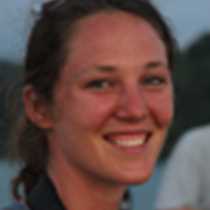The Gulf of Panama & the Panama Canal
Around 2:00 am this morning, the National Geographic Sea Lion rounded the final tip of the Azuero Penisula and sailed into the Gulf of Panama. Known as Punta Mala, or bad point, the increased rocking and rolling was felt by some, but once we reached more sheltered waters we returned to smooth sailing. Our destination for mid-morning was a cluster of islands within the Gulf, the two largest being Otoque and Bona.
After stretch class on the bridge deck, while watching the sunrise and a breakfast buffet, we still had a few hours until we reached the islands. We took the opportunity to learn about the history of the Panama Canal, which we would be entering later in the evening. The video we watched, called A Man, A Plan, A Canal, Panama (also read the same backwards), discussed how the Canal came about. The idea of the Canal was first attempted by the French in 1881. They were determined to build a sea-level canal alongside the already existing railroad that ran from the Pacific Coast of Panama (then part of Colombia) to the Caribbean side. The project proved more difficult than expected due, in part, to yellow fever and malaria, which together claimed over 22,000 workers. Construction problems and financial mismanagement drove the French company bankrupt in 1889. Panama declared independence with the help of the United States in 1903 and in 1904 the United States began construction on a new canal. More than 75,000 workers took part in the undertaking, making it one of the greatest engineering feats in the world. The canal took 10 years to complete and the first ship sailed through on August 15, 1914.
After the video, we went out in the Zodiacs to explore the perimeter of Otoque Island. The nutrient-rich waters that up-well from below this area produce a high concentration of food for many marine animals, particularly birds. We spent about an hour watching blue-footed and brown-footed boobies, magnificent frigate birds with their bright red throat pouches and brown pelicans as they searched the dark water for fish.
Back on board we pulled anchor and continued our journey to the Pacific entrance of the Panama Canal. After we received word from the Canal Authority and the pilot was settled in the bridge, we began our transit through the first two sets of locks, Miraflores and Pedro Miguel. Together, these locks lifted us 90 feet above sea level and into the Culebra Cut and Gatun Lake where we will drop anchor for the night. Tomorrow we will explore the Island of Barro Colorado before transiting the final lock and ending our journey in Colon.




